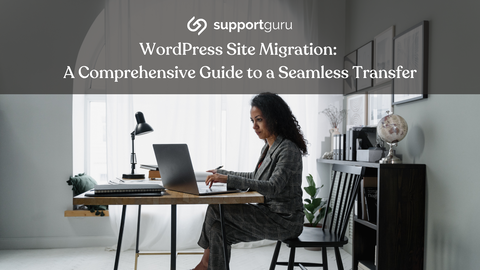Maintaining a top-notch website is crucial for business success and search engine rankings.
However, as your website grows in size and complexity, your current hosting provider may struggle to keep up.
This can lead to frustrating downtime, sluggish performance, and inadequate support, hindering your website's ability to serve its intended purpose.
Signs that Your WordPress Site Needs a New Host
Before embarking on the site migration process, it's essential to identify the signs that your current hosting provider is no longer meeting your needs.

Here are some common indicators that a new host is in order:
1. Frequent Downtime: If your site experiences unexpected downtime frequently, it can harm business and affect search rankings. Downtime can lead to lost sales, frustrated customers, and a damaged reputation.
2. Slow Performance: A slow website, even after optimizing, may indicate a need for a new host to improve user experience and search rankings. Google and other search engines favor websites that load quickly, and slow loading times can negatively impact your rankings and organic traffic.
3. Poor Customer Support: Inadequate or slow customer support during downtimes is a red flag, prompting consideration of a new hosting provider. When you need assistance, you need it promptly and effectively. A reliable hosting provider should have responsive customer support that can address your concerns quickly and efficiently.
4. Missing Key Features: If your current host lacks essential features, like e-commerce support, it might be beneficial to find one that meets your needs. As your website evolves, your hosting needs may change as well. Ensure your hosting provider offers the features and capabilities you require to run your website smoothly.
5. Lack of Automatic Backups: Regular automatic backups are crucial; if your current host doesn't provide this, it's a reason to explore other options. Automatic backups safeguard your website's data in case of unforeseen events like server failures or data breaches.
6. Manual WordPress Updates: Managed WordPress hosts should handle updates automatically. If not, it may be more efficient to switch to a host that does. WordPress updates are essential for security and compatibility, and manual updates can be time-consuming and error-prone.
Steps to Prepare for a Smooth WordPress Site Migration
Before diving into the migration process, it's essential to take some preparatory steps to ensure a smooth and successful transition.

Here's a checklist to guide you:
- Optimize File and Database Size: To minimize the time and effort involved in the migration process, it's crucial to optimize your website's file and database size.
This involves removing unnecessary backups, cache directories, unused themes, plugins, and videos. A smaller website will migrate faster and require less bandwidth.
- Advance Preparation: Before initiating the migration, take an inventory of your website's content, themes, network resources, and configurations.
Understand the size of your website, especially for large e-commerce sites, as this will influence the migration strategy and resource allocation.
- Enable Maintenance Page: To inform visitors of the ongoing migration process and prevent disruption, set up a maintenance page before migrating your website.
This will provide visitors with a clear understanding of the situation and help manage their expectations.
WordPress Site Migration Methods
There are two primary methods for migrating a WordPress site: automatic migration and manual migration.
Each method has its own advantages and disadvantages, and the choice depends on your technical expertise and comfort level.
1. Automatic Migration:
Automatic migration is the simplest and most hassle-free option for those with limited technical knowledge. It involves using a plugin or migration service offered by your new hosting provider to automate the migration process. Popular migration tools and plugins include All-in-One WP Migration and Duplicator.
2. Manual Migration:
Manual migration offers more control over the process but requires more technical expertise. It involves exporting your website's files and database from the old host, importing them to the new host, and updating the wp-config.php file with the new database credentials.
3. Post-Migration Checklist:
Once the migration is complete, it's important to perform some post-migration checks to ensure everything is functioning correctly.
Here's a checklist to follow:
-
Update Permalinks: Refresh permalinks to match the new host and ensure that all pages and links are pointing to the correct location.
-
Check Site Functionality: Thoroughly test all pages, posts, links, and forms to ensure they are functioning properly. Look for missing images, broken links, or any other inconsistencies.
-
Delete Installer and Archive Files: Remove any files created by the migration tool or plugin to avoid potential security vulnerabilities.
-
Cancel Old Hosting Account: Once you've confirmed that the new host is working properly, cancel your account with the old hosting provider to avoid duplicate charges.
4. Ensure Secure Connections
-
Configure SSL certificates to ensure secure HTTPS connections for all pages and forms.
-
Review CDN (Content Delivery Network) settings to ensure optimal content delivery globally.
-
Implement firewall rules to protect your website from unauthorized access and malicious attacks.
-
Temporary Domain Changes: Use wp-config.php to temporarily change domain settings during the migration process. This can be helpful in testing the migration before switching the site's DNS settings to the new host.
-
SSL, CDN, and Firewall Configuration: Ensure proper setup of SSL, CDN, and Firewall settings on the new host. This will help to enhance security, performance, and user experience.

WordPress Site Migration
Migrating a WordPress site can seem daunting, but with careful planning, preparation, and the right tools, it can be a smooth and successful process.
By following the steps outlined in this guide, you can effectively transfer your website to a new host, ensuring uninterrupted service and optimal performance.
Remember, regular backups and maintenance are essential for maintaining a healthy WordPress website and preventing downtime and data loss.
Luckily for you, Support Guru offers website migration within their basic package for stress-free hosting assistance, where you don’t have to worry about setting up the SSL certificates, troubleshooting consultation, uptime monitoring, and, of course, 24/7 support.
